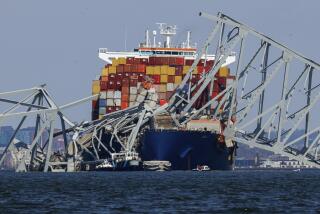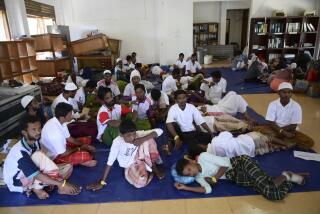Ferry sinking haunts South Korea school as classes resume

Korean Americans in Southern California remain shocked and saddened by mid-April’s fatal Sewol ferry disaster, but hope the tragedy will lead to changes in policy and cultural norms in South Korea.
ANSAN, South Korea – Seniors from the high school that lost scores of students in last week’s ferry sinking returned to class Thursday, a step toward resuming normal routines in the community that’s become the focal point of South Korea’s biggest maritime tragedy in decades.
Of the 476 people aboard the Sewol when disaster struck on April 16, 340 were staff and students from Danwon High School. As of Thursday afternoon, a total of 171 people had been confirmed dead and 131 were still listed as missing. The ship had been en route from Incheon, a port west of Seoul, to the holiday island of Jeju off the southern coast.
Students said that their time away from the classroom, mostly spent fretting over the fate of their classmates, has been emotionally taxing. “For the past week we’ve just been waiting, but no good news has come. Now it’s really hard to focus on studying,” said freshman Kim Sung-gyeom.
Down the street from the high school, a community center has been turned into a memorial hall, with portraits of the deceased students placed among bouquets of flowers and messages of condolence.
The streets of the normally quiet suburb were thronged Thursday with mourners, many of them clad in black and walking with their heads bowed. “The atmosphere around here has changed so quickly,” said student Kim Ye-bin. “All of a sudden, everything is so tough.”
No survivors have been found since the 6,825-ton ship sank eight days ago, as fast currents and poor visibility hampered divers’ efforts. On Thursday, diving missions into the hull of the Sewol focused on the third and fourth levels of the ship, where most of the cabins and the dining hall are located.
Despite having found no survivors, the rescue mission has still not been officially called off. Heavy cranes have been brought to the site of the sinking to lift the ship, but authorities have said they won’t go ahead with the raising unless they have the consent of all missing persons’ families. Getting that permission could be a stumbling block, as lifting the ship would be an admission that no survivors remain.
About 100 grief counselors have been stationed at the school, watching for signs of depression and post-traumatic stress among the students. “By being back in the school, the students will no longer feel isolated, and they can have a forum to express their difficult feelings,” Danwon High School authorities said in a morning conference call with reporters, according to the Chosun Ilbo newspaper.
Experts say that long-term psychiatric assistance will be needed to help the youths deal with the tragedy.
“Adolescents are typically vulnerable to emotional trauma even without a major event, and these students’ guilt and sadness could haunt them for a long time, so we need to ensure that they have steady counseling for an extended period,” Kim Boong-nyun, a specialist in child psychology at the Korean Academy of Child and Adolescent Psychiatry, said in an interview.
Danwon High School is also reeling from the loss of vice principal Kang Min-kyu, who committed suicide by hanging Friday. Kang had been on the trip to Jeju as a supervisor. In a suicide note found by police, he described being overcome with feelings of guilt at having been rescued from the ferry while so many students weren’t able to escape. Kang asked that his body be cremated and his ashes sprinkled in the waters where the Sewol went down.
The school won’t be free of reminders of the tragedy anytime soon: Part of the customary funeral service for a deceased Korean student is to have a family member carry a portrait of the student around the classroom and leave a bouquet of white flowers on the now vacant desk.
Students in the lower grades, as well as the 13 Danwon juniors who didn’t sign up for the trip to Jeju, are scheduled to return to class Monday. It hasn’t been announced when the 75 juniors who were rescued from the sinking ferry will resume their studies.
The field trip to Jeju was meant to be a final bit of fun for the juniors; in their second year they were set to prepare for South Korea’s notoriously difficult, and important, college entrance exam. The outcome of the test largely determines college placement, and strong results can lead to entrance at prestigious schools, which provide far better employment opportunities than mid- or lower-range schools.
The lingering trauma of the ferry tragedy could make attaining high scores on the test more difficult. “Hopefully the loss of their friends can drive them to work harder, to honor their memory,” said Hyun Joon-woo, a 28-year-old job seeker who came to pay his respects at the memorial.
[For the record, 1:50 p.m.: A previous version of this post said 325 staff and students from Danwon High School were aboard in the ferry. There were 325 students and 15 staff members on the ferry.]
Borowiec is a special correspondent.
More to Read
Start your day right
Sign up for Essential California for news, features and recommendations from the L.A. Times and beyond in your inbox six days a week.
You may occasionally receive promotional content from the Los Angeles Times.






